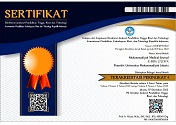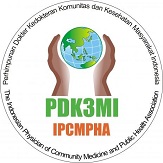THE IMPLEMENTATION OF COMPLIMENTARY FOOD ON STUNTED CHILDREN
Abstract
Background: The age of 6-24 months old is a transitional period from breast milk to solid food. It is a critical period where children could easily get malnutrition and infection. The stunting prevalence in Kanigoro Village has surpassed the healthy limit (>20%) and as such, WHO categorized it as a public health nutrition problem. This study figured out the determinant factors of the implementation of complimentary food for breast milk on 6-24 months old stunted children. Methods: This study collected the 5 (five) respondents via purposive sampling methods. The criteria used were the respondents: (1) being 6-24 months old, (2) having the height-for-age z-score value < -2 SD, (3) living in the operational area of the Public Health Center of Saptosari Gunungkidul, and (4) committing to a consensual agreement to be the subjects of the study by submitting a legal informed consent letters. The data of the study were gathered via in-depth interview. The results were then compared to International Food Policy Research Institute (IFPRI) responsive feeding indicators. Results: All of the respondents failed to do the responsive feeding properly and thoroughly. They failed to spoon feed the children, or to help the children eat by themselves, to be patient and to persuade their children to eat, to provide food in safe environment, to make feeding time as also learning time, and to care for the children. The response feeding predisposition factors are the limited time and the respondents’ perception to their children. The enabling factors are the availability and accessibility of resources. The empowering factors are the motivation from family members. Conclusion: It is recommended to involve the results of this study in basic policies formulations of many public health centers. It is expected to help children get better food intake and to optimize their growth.
Keywords
Full Text:
PDFReferences
Badan Penelitian dan Pengembangan Kesehatan Kementerian Kesehatan Republik Indonesia. Riset Kesehatan Dasar Tahun 2010. Laporan Nasional 2010. Jakarta; 2013.
Stewart CP, Iannotti L, Dewey KG, Michaelsen KF, Onyango AW. Contextualising complementary feeding in a broader framework for stunting prevention. Matern Child Nutr. 2013;9(S2):27–45.
Sawaya AL, Martins P, Hoffman D, Roberts SB. The Link Between Childhood Undernutrition and Risk of Chronic Diseases in Adulthood: A Case Study of Brazil. Nutr Rev. 2003;61(5):168–75.
Astari L, Nasoetion A, Dwiriani C. Hubungan Karakteristik Keluarga, Pola Pengasuhan dan Kejadian Stunting Anak Usia 6-12 Bulan. 2005;29:40–6.
Teshome B, Kogi-Makau W, Getahun Z, Taye G. Magnitude and determinants of stunting in children underfive years of age in food surplus region of Ethiopia: The case of West Gojam Zone. Ethiop J Heal Dev. 2010;23(2).
Ruel MT, Menon P. Child Feeding Practices Are Associated with Child Nutritional Status in Latin America: Innovative Uses of the Demographic and Health Surveys. J Nutr. 2002;132(6):1180–7.
Bentley ME, M.Wasser H, Creed-Kanashiro HM. Responsive feeding and child undernutrition in. J Nutr. 2011;141:502–7.
Aboud FE, Shafique S, Akhter S. A Responsive Feeding Intervention Increases Children ’ s Self-Feeding and Maternal Responsiveness but Not Weight Gain. J Nutr. 2009;139:1738–43.
Walker, Chang S, Powell C, Grantham-Mcgregor S. Effects of early childhood psychosocial stimulation and nutritional supplementation on cognition and education in growth-stunted Jamaican children: Prospective cohort study. Lancet. 2005;137:2464–9.
MacDonald A, Holden C. Nutrition and Child Health. London: Harcourt Publisher Limited; 2000. 55-56 p.
Harbron J, Booley S, Najaar B, Day C. III. Responsive feeding: establishing healthy eating behaviour early on in life. South African J Clin Nutr. 2013;26(S):141–9.
Hurley KM, Cross MB, Hughes SO. A Systematic Review of Responsive Feeding and Child Obesity in High-Income Countries. J Nutr. 2011;141(3):495–501.
DOI: https://doi.org/10.24853/mmj.1.1.1-9
Refbacks
- There are currently no refbacks.
Indexed by:
Work is distributed under the Creative Commons Attribution-NonCommercial 4.0 International License.
Copyright of Muhammadiyah Medical Journal (e issn: 2721-317X)













13.jpg)
